Foothill Extension: The Myth of 'On-Time' and 'On-Budget'
An analysis on the misleading, miscalculated, and mismanaged Foothill Gold Line Extension.
If you’ve been keeping up with the latest Metro project, you probably know about the Foothill Extension. The latest phase, 2B1, is extending the A line (formerly the L, and before that, the Gold Line) from its current terminus at APU/Citrus College in Azusa to the new terminus at the Pomona - North Metrolink station. It will add three more stations along the way, including stops at Glendora, San Dimas, La Verne, and then its new terminus at the similarly named Pomona (North) station. I’m excited for these new stations, but it hasn’t been all easy going.
In fact, some of you may be wondering why the current phase is 2B1. This is a total of three nested phases, and it’s not an accident. In fact, it’s been a flaw of the Foothill Gold Line Construction Authority’s (the agency behind the extension) constant overpromises, miscalculations and deflections. The Authority constantly touts its claims that several of the phases were completed on-time and under-budget, but this is blatantly untrue. The mere fact that there are three nested phases showcases how bad of a job the Authority has done when it comes to these projects.
I’ll be covering the several mistakes and missteps the agency has made over the years, but first we need to go back to the origin of the Authority.
SB1847 & The Birth of the Construction Authority
If you look closely at this project, you’ll notice that it’s not Metro doing the construction. Unlike for example, the Metro D Line Extension, the Crenshaw/LAX Line (now called the K), and other extension projects, the Foothill Extension is not managed by Metro. The Authority is in charge of planning, construction and public outreach at every step of the process until they turn over the tracks so Metro can use them. This is for a very specific reason - instead of being a solely Metro-administered project, the Foothill Extension was originally created by the California State Legislature in SB 1847.
In fact, Metro originally did plan the Metro Gold Line (in its original segment from L.A. Union Station to Pasadena). However, they suspended it because of budget overruns stemming from the Red Line construction, and concerns from politicians and locals who were worried about mismanagement of funds. In response, the California State Legislature created the Pasadena Blue Line Construction Authority. This original Authority was responsible for the design, contracting, and construction of the Los Angeles to Pasadena segment of the Gold Line. Notice the mismatch in the names; Once it was clear the Pasadena Blue Line would not connect to the original Blue Line (Los Angeles → Long Beach), the line (and Authority) were renamed the Gold Line and Gold Line Construction Authority, respectively. This original legislation placed it in charge of that original construction, as well as any “fixed mass transit guide way eastward to Claremont.” Later, this final terminus was changed to Montclair in San Bernardino County.
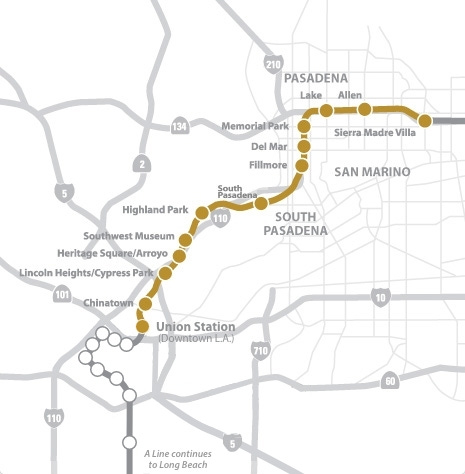
Phase 1: LAUS → Pasadena
The first segment of the Gold Line was a massive success. It was completed on-time and under-budget, after the stall and suspension by Metro. It was turned in on July 26, 2003, although Metro spent an additional $130 million purchasing LRVs (Light Rail Vehicles) for the line, as well as testing them.1
In fact, the success of the first phase led to the development of a similar approach on another expansion project: The Expo Line, later known as the E line. A similarly named “Exposition Metro Line Construction Authority” was established, for the sole purpose of building out the full line along existing and new rights-of-way. The Expo line stretched from Pico Station in Downtown L.A. all the way through Culver City and eventually Santa Monica.
Unfortunately, the success of the first phase didn’t translate over to the later phases.
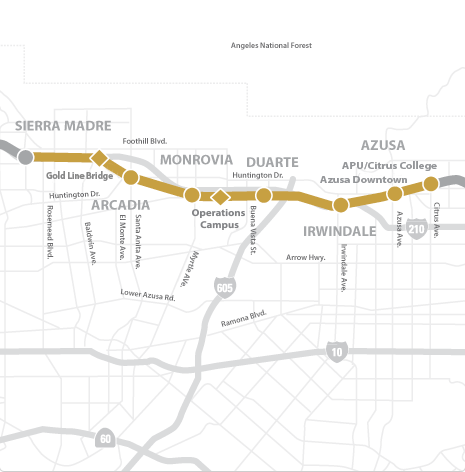
Phase 2A: Pasadena → Azusa
The second segment of the Gold Line Extension was set to extend the line from its terminus at Sierra Madre Villa Boulevard in Pasadena all the way to Azusa. Unfortunately, this is where the miscalculations began to set in.
In the original 2007 Environmental Impact Report, the Authority evaluated two options for Phase 2 of the Foothill Extension. They evaluated the Full Build Alternative (Pasadena → Montclair) and the LRT to Azusa Alternative (Pasadena → Azusa). The Full Build Alternative was calculated to cost approximately $976 million, while the LRT to Azusa Alternative was calculated to cost $402 million.2
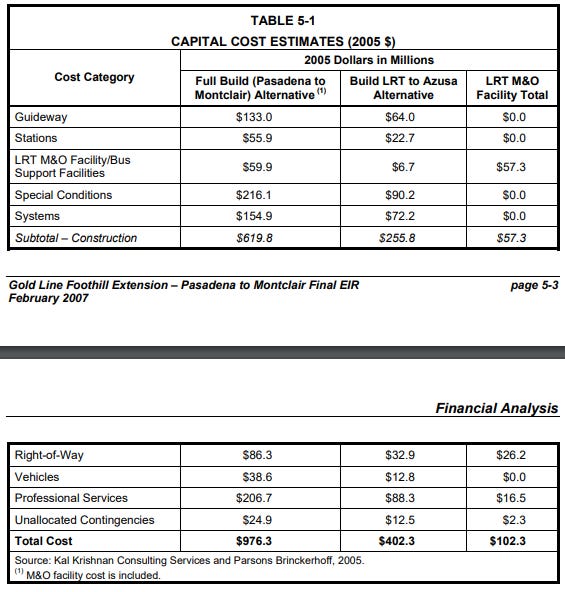
Interestingly, the document included the cost of the maintenance facility in the Full Build Alternative, but not the LRT to Azusa Alternative. The total cost of the LRT to Azusa Alternative, including the M&O facility would’ve approached $505 million.
These numbers did not match up, however, to the Authority’s own numbers. In fact, several articles from 2008 talk about the mismatch between the Authority’s numbers and Metro’s own estimates.3
He said that the MTA estimates the price of the extension project at $570 million to reach Azusa/Glendora, whereas the Gold Line Authority puts the price tag at $400 million.
Source: https://www.dailybreeze.com/2008/07/17/mta-funds-for-gold-line-could-double/
In fact, later studies further credited Metro’s estimate as the correct one. An Economic Impact Study on Phase 2A, published January 11, 2010, estimated initial spending of $490 million, plus $79 million for land acquisition and fees, with a total of $569 million.4
After contract awards, though, the project budget was set at $690 million, which was later revised even further to $735 million.5 The Authority then claimed that Phase 2A came in $100 million under budget.6 Although technically true, as approximately $96 million was left over from the Proposition C and Measure R allocations,78 this was still several hundred million over their original estimates and their misleading quotes stating Phase 2A would cost $400 million. This was also despite knowing that the LRT Maintenance & Operation facility would have to be completed as part of the project.
After this, things only got messier with Phase 2B.
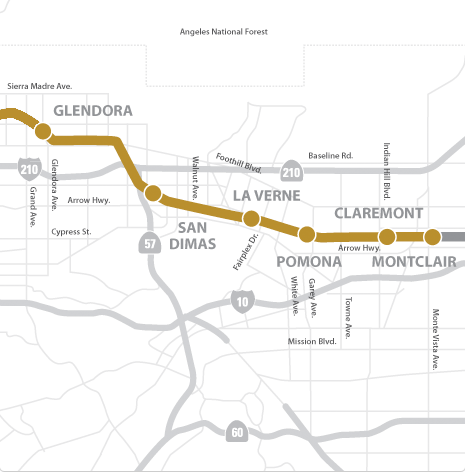
Phase 2B(1): Azusa → Montclair Pomona
Originally just supposed to be called Phase 2B, this phase was supposed to mark the final completion and dissolution of the current form of the Authority, after it reached its final terminus based on current legislation. It was poised to extend the A line six stops, including stops in Glendora, San Dimas, La Verne, Pomona, Claremont and ultimately Montclair.
In 2017, they received a wealth of funding from different sources, including more than $1 billion from Measure M, and over $1.4 billion in total.9 For reference, the D Line Extension (Phase 3, the only one funded by Measure M) only got $994 million from Measure M, and the ESFV light rail project got $810 million.10 In fact, the Foothill Extension was the only project in the first 21 Measure M allocations to break the $1 billion mark.
Even with this extraordinary wealth of funding, the Authority STILL failed to accurately predict costs. In July 2019, the Authority released a statement confirming that the project would have to be split into further phases. The Authority miscalculated the cost of the extension, and worse, during the bidding phase. All four of the bids the Authority received were hundreds of millions of dollars over secured funding.11 The Authority was forced to split the project again, into the third nested phase: Phase 2B1, extending the line only to Pomona.
On top of this, in August 2019, SGVCOG, the San Gabriel Valley Council Of Governments, was essentially forced to secure an additional $126 million to address the funding gap to complete Phase 2B1.12 13
Even with several key miscalculations and several instances of mismanagement by the Authority, it still released the following press release. In the press release, they claimed that “The $1.5 billion, four-station Foothill Gold Line from Glendora to Pomona reached substantial completion on time and on budget on Friday, January 3, 2025.”14 This is blatantly untrue, and misleading. Not only was the total budget over the original estimates of the $1.4 billion allocated in 2017, the project did not reach Montclair as originally planned. Additionally, the remaining portion, Phase 2B2 still had not even begun construction and was looking at a 4-5 year construction period when the contractor was selected (note: the contractor had not been selected at the time of the press release).
Phase 2B2: Pomona → Montclair
The mess with the next phase begins right before the bidding phase. Only one contractor (the current Glendora to Pomona contractor), Kiewit, replied to the RFQ (Request For Qualifications). As pointed out by numble, “when only one bidder applies to a LA Metro solicitation… they do an investigation into why only one bidder applied and they may restart the process with a goal of getting more bidders.” Instead of fairly redoing the screening process, the Authority qualified Kiewit as the only contractor good enough for the project.
Unsurprisingly, when Kiewit delivered its final offer on March 19, the “bid remained hundreds of millions of dollars above expert estimates and available funding.”15 Notably, this is in a press release by the Authority itself. At the end of the press release, the Authority still had the nerve to claim that the “Construction Authority is proud of our 25-year track record of delivering three project segments on time and on budget.”
So not only is the final portion of the Foothill Extension not yet under construction, it is still over-budget and miscalculated.
Misuse of funds, every step of the process
Despite the clear incompetence the Authority has exhibited in every phase of the project, they still have no problem patting themselves on the back and congratulating themselves. Stemming from the original Phase 1, the Authority gave its employees bonuses equating to 40% of their salary.16
In October 2002, the Authority Board approved an Employee Retention and Severance Plan for Phase 1 of the Project… Authority employees received 10% of salary for each of the following milestone bonuses:
1) Substantial completion
2) Revenue operations
3) Under budget
4) A lump sum bonus for staying six months past revenue operations.
In my opinion, these bonuses are not as egregious as those to follow. It’s true that Phase 1 was significantly under-budget, and the other bonuses seem relatively fair.
Yet with the much more troubled Phase 2A, the Authority was still happy to pat themselves on the back with a 40%. Notice that the under-budget bonus was replaced with a punch list completion bonus, and the substantial completion bonus was split into specific project completion bonuses.
In October 2014, the Authority Board approved an Employee Retention and Severance Program for Phase 2A of the Project for all 13 employees.
Authority employees received 10% of salary for each of the following milestone bonuses:
1) M&O Completion
2) Parking Structures Completion
3) Revenue Operations
4) Punch List Completion
This is far more egregious. First off, the Authority is not responsible at all for the actual construction. They are responsible for administration, planning, and management of the construction contractor. So I ask you: why are they giving themselves bonuses for the contractor’s hard work? Afterwards, why are they giving themselves bonuses for Metro’s Revenue Operations? And finally, why are they giving themselves bonuses for the completion of the final bit of non-critical work completed by the contractor?
And again, for the even more troubled Phase 2B1. This time, the Authority was happy to again give themselves a pat on the back, with an EVEN HIGHER 50% bonus, per employee.
For the Phase 2B extension to Pomona, as in Phase 1 and Phase 2A, to address the concern that it will become increasingly challenging to retain key employees between now and the end of Phase 2B to Pomona, it is recommended the Authority Board adopt a similar employee retention program as follows:
All Authority employees earn a lump sum payment equal to 10% of an employee’s regular gross annual wages which are paid on a recurring bi-weekly basis for each of the following milestones bonuses:
1) Grade Crossing
2) Stations
3) Systems Integration
4) Pre-Revenue Testing
5) Draft Punch List
Notably, none of this is the Authority’s actual work. The contractors are responsible for all hard work going into construction, including grade crossings, station construction, systems integration, and the punch list items. Additionally, Metro is responsible for Pre-Revenue Testing. So, why is the authority giving itself such absurd bonuses?
Also notable is the fact that the Authority’s CEO, which manages ~13 employees, makes $50,000 more than Metro’s CEO,1718 who manages more than 12,000 employees,19 and manages exponentially more projects, rail operations, bus operations, and transportation across all of L.A. County.


So, the next time you see a Foothill Gold Line press release talking about how the project is consistently ‘under-budget’ and ‘on-time,’ think twice. I’m far more of a fan of Metro building and managing this project, than the zombie agency that currently is. If you want to share your thoughts with the Authority, I highly recommend showing up to the next board meeting. You can find a calendar here.
Special thanks to numble, who dropped this bombshell of a post and kicked off my research into Foothill Gold Line.
Streeter, Kurt, and Tina Daunt. "Hopes for Urban Revival Ride on LA-Pasadena Line." Los Angeles Times 26 July 2003: A1.
https://foothillgoldline.org/wp-content/uploads/converted-images/uploads/Chapter%205.pdf
https://www.dailybreeze.com/2008/07/17/mta-funds-for-gold-line-could-double/
https://web.archive.org/web/20250126223009/http://wayback.archive-it.org/all/20121110011217/http://www.aia.org/aiaucmp/groups/aia/documents/pdf/aiab082856.pdf
https://web.archive.org/web/20120407003605/http://www.metro.net/board/Items/2011/03_March/20110324RBMItem7.pdf
https://x.com/IWillRide/status/1702418142771978697
https://datamade-metro-pdf-merger.s3.amazonaws.com/2017-0338.pdf
https://foothillgoldline.org/default/project-funding/
https://datamade-metro-pdf-merger.s3.amazonaws.com/2017-0338.pdf
https://foothillgoldline.org/wp-content/uploads/2019/08/ProjectFactSheet-2019-final.pdf
https://docs.wixstatic.com/ugd/f815d4_d9865c03e0bc482eac6bf2ff8a386918.pdf
https://x.com/hildasolis/status/1159670758253010945
https://foothillgoldline.org/wp-content/uploads/2025/04/Quarter1_Newsletter_SC_2025ed4.pdf
https://foothillgoldline.org/wp-content/uploads/2025/03/2025-03-26-FINAL-Agency-Statement-DB-Procurement-Cancelled.pdf
https://foothillgoldline.org/wp-content/uploads/2024/04/2024-05-01-Mgmt-Pers-Meeting-Packet-FINAL.pdf
https://transparentcalifornia.com/salaries/los-angeles-county-metropolitan-transportation-authority/?&s=-base
https://transparentcalifornia.com/salaries/2023/foothill-gold-line-construction-authority/?&s=-base
https://www.metro.net/about/facts-glance/


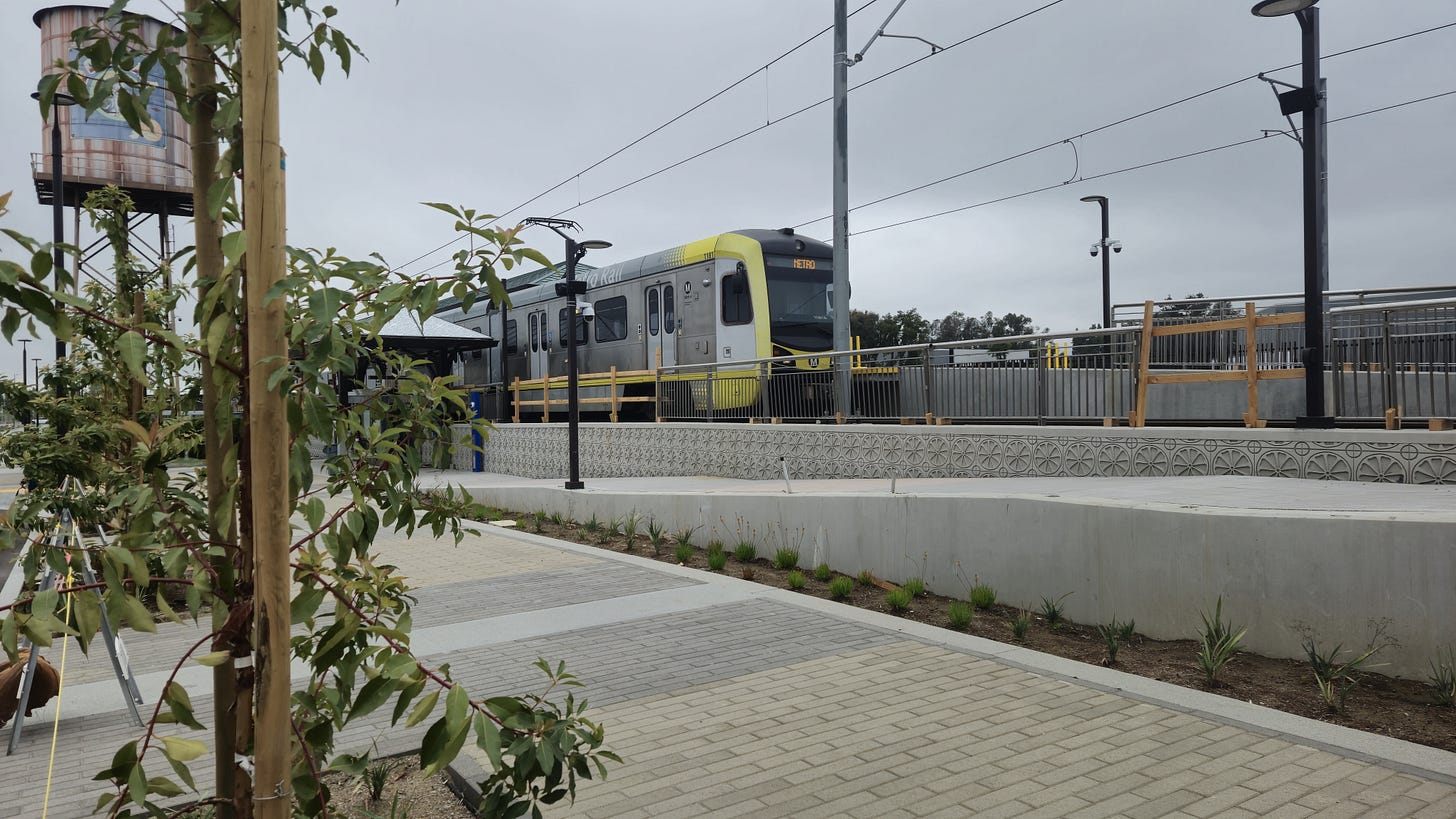
Excellent article. I'd just add that when this went before taxpayers in 2008 the completion date to Claremont was initially 2017. Besides the dollars I'd question the "on-time" too. Last I heard it was looking like 2031 now.
The Agency's meetings in August have all been cancelled. I wonder if it's in response to your excellent post.